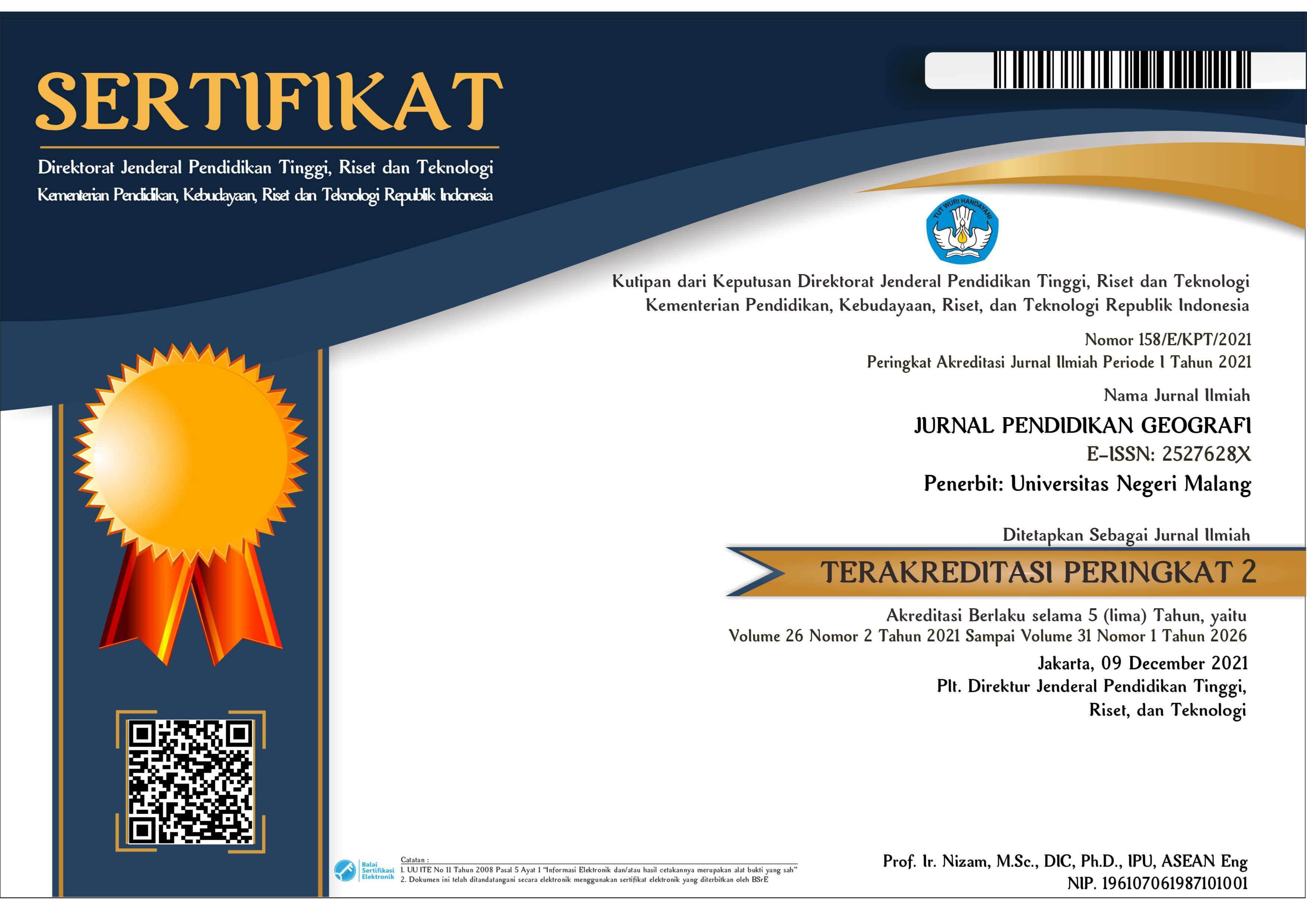The spatial agglomeration of the labor manufacturing industry in Central Java Province, 2005–2015
Abstract
Keywords
Full Text:
PDFReferences
Arsyad, L. (2015). Konsep dasar ekonomika industri. UT.
Asheim, B. T., Grillitsch, M., & Trippl, M. (2016). Regional innovation systems: Past–present–future. In Handbook on the Geographies of Innovation. Edward Elgar Publishing.
Asheim, B. T., Isaksen, A., & Trippl, M. (2019). Advanced introduction to regional innovation systems.
Athukorala, P., & Narayanan, S. (2018). Economic corridors and regional development: The Malaysian experience. World Development, 106, 1–14.
Awumbila, M. (2017). Drivers of migration and urbanization in Africa: Key trends and issues. International Migration, 7(8).
Azhari, A. R. (2019). Determinan pertumbuhan penyerapan tenaga kerja pada sektor industri manufaktur di Jawa Barat tahun 2005-2018. Universitas Siliwangi.
Budiyanti, E. (2016). Penguatan kembali industri manufaktur Indonesia. Majalah Info Singkat Ekonomi dan Kebijakan Publik, 8(12), 13–16.
Busch, J., Foxon, T. J., & Taylor, P. G. (2018). Designing industrial strategy for a low carbon transformation. Environmental Innovation and Societal Transitions, 29, 114–125.
Cainelli, G., Ganau, R., & Giunta, A. (2018). Spatial agglomeration, global value chains, and productivity. Micro-evidence from Italy and Spain. Economics Letters, 169, 43–46.
Carvalho, N., Chaim, O., Cazarini, E., & Gerolamo, M. (2018). Manufacturing in the fourth industrial revolution: A positive prospect in sustainable manufacturing. Procedia Manufacturing, 21, 671–678.
Chandrasekhar, S., & Sharma, A. (2015). Urbanization and spatial patterns of internal migration in India. Spatial Demography, 3(2), 63–89.
Davis, C., & Hashimoto, K. (2018). Corporate tax policy and industry location with fully endogenous productivity growth. Economic Inquiry, 56(2), 1136–1148.
Day, L. H., & Xia, M. (2019). Migration and urbanization in China. Routledge.
Dina, H. (2015). Analisis faktor-faktor yang mempengaruhi penyerapan tenaga kerja sektor industri manufaktur di Sumatera Barat. UPT. Perpustakaan.
Drucker, J., & Feser, E. (2012). Regional industrial structure and agglomeration economies: An analysis of productivity in three manufacturing industries. Regional Science and Urban Economics, 42(1–2), 1–14.
Ermansyah, H., & Mahi, B. R. (2019). Pengaruh pajak penghasilan badan terhadap permintaan tenaga kerja pada perusahaan manufaktur. Forum Ekonomi, 21(2), 143–153.
Fang, C., & Yu, D. (2017). Urban agglomeration: An evolving concept of an emerging phenomenon. Landscape and Urban Planning, 162, 126–136.
Fatmawati, P., & Utomo, Y. P. (2017). Analisis konsentrasi spasial industri manufaktur dengan tinjauan empiris di Kabupaten Sukoharjo. Universitas Muhammadiyah Surakarta.
Ginting, S. (2021). Faktor-faktor yang mempengaruhi penyerapan tenaga kerja sektor industri manufaktur di Kabupaten Malang tahun 2010-2018. Jurnal Ilmiah Mahasiswa FEB, 9(1).
Green, L. (2018). Migration, urbanization, and national development in Nigeria. In Modern Migrations in Western Africa (pp. 281–304). Routledge.
Guo, Q., & He, C. (2017). Production space and regional industrial evolution in China. GeoJournal, 82(2), 379–396.
He, C., Mao, X., & Zhu, X. (2018). Industrial dynamics and environmental performance in urban China. Journal of Cleaner Production, 195, 1512–1522.
Kennedy, P. S. J. (2017). Modul ekonomi mikro teori perilaku produsen.
Kornfeld, B. J., & Kara, S. (2015). Industry-university collaboration in sustainable manufacturing. Procedia CIRP, 29, 8–12.
Kristianto, A. H., & Nurcahyo, A. C. (2020). Potret kondisi perekonomian Indonesia.
Kumala, A. R., & Rostiana, E. (2018). Faktor-faktor yang mempengaruhi investasi pada sektor industri manufaktur di Indonesia periode 2000-2017. Perpustakaan Fakultas Ekonomi dan Bisnis Unpas Bandung.
Kuncoro, M., & Wahyuni, S. (2009). FDI impacts on industrial agglomeration: The case of Java, Indonesia. Journal of Asia Business Studies, 3(2), 65–78.
Kusumaningrum, E. (2017). Analisis penyerapan tenaga kerja sektor industri manufaktur di Indonesia. Universitas Gadjah Mada.
Latif, H. H., Gopalakrishnan, B., Nimbarte, A., & Currie, K. (2017). Sustainability index development for manufacturing industry. Sustainable Energy Technologies and Assessments, 24, 82–95.
Lau, A. K. W., Lee, P. K. C., & Cheng, T. C. E. (2018). An empirical taxonomy of corporate social responsibility in China’s manufacturing industries. Journal of Cleaner Production, 188, 322–338.
Lau, P. L., Koo, T. T. R., & Dwyer, L. (2017). Metrics to measure the geographic characteristics of tourism markets: An integrated approach based on Gini index decomposition. Tourism Management, 59, 171–181.
Liu, Y., Zhang, X., Kong, X., Wang, R., & Chen, L. (2018). Identifying the relationship between urban land expansion and human activities in the Yangtze River Economic Belt, China. Applied Geography, 94, 163–177.
Manyika, J., Lund, S., Chui, M., Bughin, J., Woetzel, J., Batra, P., Ko, R., & Sanghvi, S. (2017). What the future of work will mean for jobs, skills, and wages. McKinsey Global Institute.
McCann, P., & Van Oort, F. (2019). Theories of agglomeration and regional economic growth: A historical review. In Handbook of regional growth and development theories. Edward Elgar Publishing.
Meijer, A., & Bolívar, M. P. R. (2016). Governing the smart city: A review of the literature on smart urban governance. International Review of Administrative Sciences, 82(2), 392–408.
Meijers, E., & van der Wouw, D. (2019). Struggles and strategies of rural regions in the age of the ‘urban triumph’. Journal of Rural Studies, 66, 21–29.
Mori, T., & Smith, T. E. (2015). On the spatial scale of industrial agglomerations. Journal of Urban Economics, 89, 1–20.
Muta’ali, L. (2015). Teknik Analisis Regional untuk perencanaan wilayah, tata ruang dan lingkungan. Yogyakarta: Badan Penerbit Fakultas Geografi Universitas Gadjah Mada, 347.
Nugroho, Y. D., & Wahyuni, K. T. (2019). Aglomerasi dan dinamika industri manufaktur pada era revolusi industri 4.0 di koridor ekonomi Jawa. Seminar Nasional Official Statistics, 1, 687–699.
Pike, A., Rodríguez-Pose, A., & Tomaney, J. (2017). Shifting horizons in local and regional development. Regional Studies, 51(1), 46–57.
Putri, A. S. P. (2019). Perkembangan industri knalpot di Kelurahan Purbalingga Lor, Kecamatan Purbalingga, Kabupaten Purbalingga tahun 1975-2008. Universitas Diponegoro.
Rakhmawati, A., & Boedirochminarni, A. (2018). Analisis tingkat penyerapan tenaga kerja sektor industri di Kabupaten Gresik. Jurnal Ilmu Ekonomi JIE, 2(1), 74–82.
Rosyana, N., & Soelistyo, A. (2020). Analisis penyerapan tenaga kerja pada industri manufaktur besar dan sedang pada tingkat kabupaten/kota ii Provinsi Jawa Timur (2017-2019). Jurnal Ilmu Ekonomi JIE, 4(4), 723–731.
Saputra, Y. T., & Budiani, S. R. (2017). Kajian value chain pada industri knalpot di Kecamatan Purbalingga, Kabupaten Purbalingga, Jawa Tengah. Jurnal Bumi Indonesia, 6(3).
Setyoningrum, S. (2017). Faktor-faktor yang mempengaruhi Penanaman Modal Asing (PMA) langsung di Purbalingga. Fokus Bisnis: Media Pengkajian Manajemen dan Akuntansi, 16(2), 103–123.
Shao, S., Tian, Z., & Yang, L. (2017). High speed rail and urban service industry agglomeration: Evidence from China’s Yangtze River Delta region. Journal of Transport Geography, 64, 174–183.
Sholihah, I. M., Syaparuddin, S., & Nurhayani, N. (2017). Analisis investasi sektor industri manufaktur, pengaruhnya terhadap pertumbuhan ekonomi dan penyerapan tenaga kerja di Indonesia. Jurnal Paradigma Ekonomika, 12(1), 11–24.
Siregar, K. L. S. (2018). Analisi faktor-faktor yang mempengaruhi penyerapan tenaga kerja sektor industri manufaktur (besar dan sedang) Kabupaten Deli Serdang. Universitas Sumatera Utara.
Siregar, R. T., Rahmadana, M. F., Purba, B., Nainggolan, L. E., Sudarmanto, E., Nainggolan, P., Basmar, E., & Siagian, V. (2021). Ekonomi industri. Yayasan Kita Menulis.
Sosnovskikh, S. (2017). Peculiarities in the development of special economic zones and industrial parks in Russia. European Journal of Geography, 8(4), 82–102.
Sumarsono, S. (2009). Ekonomi sumber daya manusia teori dan kebijakan publik. Jogyakarta: Graha Ilmu.
Taddeo, R., Simboli, A., Ioppolo, G., & Morgante, A. (2017). Industrial symbiosis, networking and innovation: The potential role of innovation poles. Sustainability, 9(2), 169.
Wang, B. (2018). The future of manufacturing: A new perspective. Engineering, 4(5), 722–728.
Wang, J., Lin, Y., Glendinning, A., & Xu, Y. (2018). Land-use changes and land policies evolution in China’s urbanization processes. Land Use Policy, 75, 375–387.
Wang, X. R., Hui, E. C. M., & Sun, J. X. (2017). Population migration, urbanization and housing prices: Evidence from the cities in China. Habitat International, 66, 49–56.
Wu, S., & Yang, Z. (2018). Locating manufacturing industries by flow-capturing location model–Case of Chinese steel industry. Transportation Research Part E: Logistics and Transportation Review, 112, 1–11.
Yogi, P. P. (2018). Analisis faktor-faktor yang mempengaruhi penyerapan tenaga kerja industri manufaktur besar dan sedang di provinsi Sumatera Barat. Universitas Andalas.
You, H., & Bie, C. (2017). Creative class agglomeration across time and space in knowledge city: Determinants and their relative importance. Habitat International, 60, 91–100.
Zhen, F., Cao, Y., Qin, X., & Wang, B. (2017). Delineation of an urban agglomeration boundary based on Sina Weibo microblog ‘check-in’ data: A case study of the Yangtze River Delta. Cities, 60, 180–191.
Zheng, Q., & Lin, B. (2018). Impact of industrial agglomeration on energy efficiency in China’s paper industry. Journal of Cleaner Production, 184, 1072–1080.
Zulkifli, Z. (2016). Faktor-faktor yang mempengaruhi penyerapan tenaga kerja di sektor industri manufaktur di Provinsi Sulawesi Selatan tahun 2004-2013. Universitas Islam Negeri Alauddin Makassar.
DOI: http://dx.doi.org/10.17977/um017v27i12022p38-50
Refbacks
- There are currently no refbacks.
Copyright (c) 2022 Jurnal Pendidikan Geografi: Kajian, Teori, dan Praktek dalam Bidang Pendidikan dan Ilmu Geografi

This work is licensed under a Creative Commons Attribution-ShareAlike 4.0 International License.
Jurnal Pendidikan Geografi: Kajian, Teori, dan Praktek dalam Bidang Pendidikan dan Ilmu Geografi is licensed under Creative Commons Attribution-ShareAlike 4.0 International License,
JPG Indexed By:
View My Stats








12.png)
